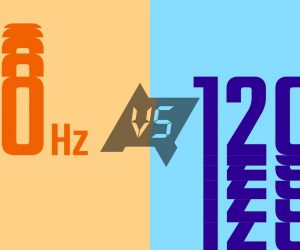You will have observed telephones popping out with 90 Hz, 120 Hz, and even 144 Hz and 240 Hz shows and been a bit confused — do not panic, you are not alone. Show refresh price impacts each side of a tool’s consumer interface, from texting and common productiveness to video games and digicam interface. You will need to know what these numbers are and after they matter, since many individuals might not even want a 120 Hz or greater show. Refresh price is arguably probably the most noticeable change a producer could make to a tool’s show, however producers love enjoying the numbers sport to get extra models out the door. It is essential to know when and why it issues, so you’re conscious of why chances are you’ll wish to spend additional on a tool with a excessive refresh price show.
What’s show refresh price?
Digital shows do not work the identical method because the human eye does – the picture on a display screen isn’t transferring. As an alternative, they show a sequence of photographs at totally different factors of movement. This simulates easy movement by tricking our brains to fill within the microscopic blanks between static photographs. As a reference, most film productions use 24 frames per second (FPS), whereas TV productions use 30 FPS within the US (and different nations with 60 Hz energy grids or NTSC broadcast techniques) and 25 FPS within the UK (and different nations with 50 Hz energy grids or PAL broadcast techniques).
Though most motion pictures are shot in 24p (aka 24 body per second), the usual was initially adopted as a result of price constraints—24p was thought the be the bottom refresh price that supplied easy movement. Many filmakers proceed to make use of the 24p-standard as a result of its cinematic feel and look. Tv exhibits are sometimes shot in 30p, and the frames are doubled (a way generally known as pull-down) for 60 HZ televisions. The identical holds true for displaying 25p content material on a 50 Hz show. The conversion is a bit more complicated for 24p content material. A method known as 3:2 pull-down interlaces frames as a way to stretch them out to suit the 25 or 30 FPS goal.

Capturing in 50 or 60p has turn out to be extra widespread on video streaming platforms like YouTube and Netflix. The underside line right here is that until you’re watching or modifying high-refresh-rate content material, you’ll not want something above 60 FPS. That being stated, as excessive refresh price shows enter the mainstream, high-refresh-rate content material may also turn out to be extra fashionable. Increased refresh charges may very well be significantly helpful for sports activities broadcasts since split-second motions are related to viewers in some eventualities.
Refresh price is measured in Hertz (Hz), which tells us what number of instances per second a brand new picture is proven. As talked about earlier than, movie typicaly makes use of 24 FPS as a result of it’s the minimal body price to convey easy movement. That being stated, updating the picture extra often permits quick movement to look smoother. The distinction is greatest illustrated by the Blur Busters UFO Take a look at.
A associated side-note: in case you are recording video on a smartphone, chances are you’ll wish to think about using the 30 FPS mode until you’re recording actually high-speed movement. This might profit low-light efficiency – a decrease body price means the person exposures may be barely longer – and save area in your machine.
What are smartphone refresh charges?
Smartphone refresh charges range between 60Hz, 90Hz, 120Hz, 144Hz, and fewer typically 240Hz. The commonest high-refresh choice is 120Hz, with 60Hz having been the usual for a very long time and now principally showing on lower-end gadgets and the base-model iPhone 13. In case your telephone has a high-refresh show, you’ll be able to often alter the refresh price within the settings app. A typical compromise discovered principally in Samsung telephones with high-refresh shows is that the decision is lowered from 1440p to 1080p when utilizing high-refresh mode.
.jpg)
What’s an adaptive refresh price?
A more moderen function in flagship gadgets is adaptive or variable refresh price expertise. This function permits gadgets to modify between totally different refresh charges on the fly, relying on the content material on the display screen. The good thing about adaptive refresh is conserving battery life, which is without doubt one of the greatest points with excessive refresh charges on cellular gadgets.
Samsung was the primary to function adaptive refresh price expertise, on its Galaxy Notice 20 Extremely. The Galaxy S22 Extremely is one other prime instance of this and can go from 120Hz all the best way all the way down to 1Hz. Different implementations have much less vary, equivalent to the ten – 120Hz vary seen on the Google Pixel 6 Professional and the 48 – 120Hz out there on the Samsung Galaxy S22+.
Adaptive refresh price is useful as a result of all of us use our gadgets otherwise. Some customers play extra video games, whereas others use their gadgets extra for texting, shopping the online, or watching movies. These totally different use circumstances have totally different calls for — excessive refresh charges offer you a aggressive edge in video games by decreasing system latency. Movies, then again, have a static body price, and textual content may be static for lengthy intervals. Utilizing a excessive refresh price mode whereas viewing a 30FPS video could be mindless because the video can not show something above 30Hz—you can not add info that doesn’t exist.
Disappointingly, when Samsung launched the Galaxy S22 and S22+, it initially claimed these gadgets supported adaptive refresh charges from 10 Hz to 120 Hz. It was later revealed to reviewers and different media that this was not true, and the shows on the S22 and S22+ solely assist refresh charges from 48 Hz to 120 Hz. This will not seem to be an enormous deal, however the implications on battery life are important – particularly contemplating the S22 and S22+ have decrease battery capacities in comparison with the Galaxy S22 Extremely, which does assist an adaptive refresh price as little as 1 Hz.
What are the professionals of high-refresh-rate shows?
The advantages of utilizing a high-refresh-rate show are quite a few, even on the whole use. Animations like scrolling or opening and shutting home windows and apps will really feel snappier, and the interface within the digicam app could have much less lag. The improved fluidity of animations and UI parts makes interacting together with your telephone really feel extra pure. In the case of gaming, the advantages are much more related and will even present a aggressive edge—you’ll obtain up to date details about the gameplay extra often than on a daily 60 Hz display screen—by permitting you to react to occasions extra shortly.
What are the cons of high-refresh-rate shows?
The largest points attributable to high-refresh-rate shows are battery drain, jelly scroll, and backbone compromises. Clearly, a show makes use of energy when displaying a picture. Each time it updates the picture, a bit extra energy is used. This improve in energy draw means shows with fastened excessive refresh charges may end up in some fairly poor battery life.
Jelly scrolling is a time period that describes a difficulty attributable to the best way shows refresh and the show orientation. As a result of shows refresh line-by-line, from one edge to a different (often prime to backside), some gadgets have points the place one aspect of the display screen will seem to be it’s transferring forward of the opposite. Jelly scrolling also can current as textual content or UI parts being compressed or stretched because of the highest of the content material displaying fractions of a second forward of the underside (or vice-versa). The phenomenon is especially egregious within the 2021 iPad Mini, which had a 60 Hz show. Going to a better refresh price may truly cut back jelly scrolling, though it could possibly happen at any refresh price.
Excessive refresh charges put extra stress on the processing {hardware} of your machine, that means the CPU and GPU may get hotter consequently. Momentary slowdowns or hitches may additionally happen because of the processing elements being unable to maintain up. Producers have handled hitches and slow-downs by forcing a compromise between high-refresh mode and high-resolution mode. Samsung is thought for making customers select between 120 Hz at 1080p, and 60 Hz at 1440p. That is performed in software program and customers can change between the 2 and resolve if they need a better decision or refresh price.
A high-refresh-rate show is implausible to have in a telephone, however it’s not the one specification to contemplate. Even a 120 Hz show can have poor brightness, colour copy, or response charges. These can all negatively have an effect on consumer expertise, so it is very important take a look at show panels as an entire, relatively than concentrate on only one specification.
Ought to I actually care about excessive refresh charges?
Whereas it’s nice to see excessive adoption charges for issues that make a distinction in on a regular basis use, it is very important understand that 60 Hz shows are nonetheless completely able to delivering a easy expertise. Whether or not it’s best to get a high-refresh show relies upon utterly in your particular person wants. Consoles solely lately acquired assist for above 60 FPS, and lots of cellular video games like Closing Fantasy VII are solely simply now getting assist for 60 FPS gameplay. Many of the best Android telephones in the marketplace ship with adaptive refresh charges however do not low cost price range telephones with 60Hz panels until you are a gamer or require a stutter free expertise for inventive duties.
Learn Subsequent
About The Writer


Take a comment